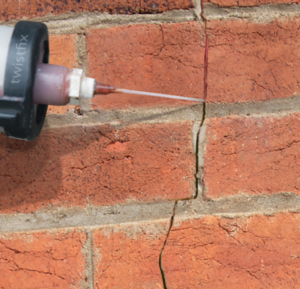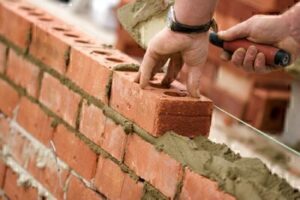Masonry Repair Charleston SC involves the upkeep, replacement, and care of brick or stone structures. These include fireplaces, chimneys, walls, fences, and barbecues.
All masonry structures will eventually require repair and restoration. This is due to normal wear and tear, weather, and other factors. Left unattended, these problems will balloon into costly and invasive repairs.

While some cracks in brick walls are unavoidable, they can be repaired. Usually these are cosmetic, but they should not be ignored as they can grow and become a structural problem in your home. These cracks should be repaired as soon as possible. The longer you wait, the worse they can become, leading to water and insects finding their way into your home.
Cracks can be caused by many things including movement, overloading, and material failure. Some cracking is due to movements in the ground that cause the foundation of your home to shift. This can be caused by soil conditions, adjacent excavations, and tree roots. Movements can also be caused by a change in moisture content of the surrounding soil.
To correct these types of cracks, a professional mason will dig out the cracked mortar and apply a new layer of mortar. This is known as tuckpointing. The area should be cleaned to remove any loose debris, and the crack should be made wider on the inside than it is on the face to allow for proper adhesion. A wood stick, grout bag, or narrow trowel is used to force the mortar into the voids. Once the mortar dries, it can be sculpted to match the rest of the joints.
If you see small or hairline cracks in your brick, they should be looked into by an expert as they are likely a sign of an underlying issue. Taking care of these issues is much easier than waiting until a larger crack forms that can be more difficult to repair.
Bulging bricks often occur when water gets into the wall and expands. This can happen when water seeps in through damaged mortar or rusting anchors, or when water is allowed to freeze behind the brick wall during cold periods. This can cause the masonry to bow or bulge, and it must be repaired by a professional mason to prevent detachment from or even collapse of the structure.
When you notice a portion of your brick wall that appears to be swelling, contact a professional mason immediately. They will be able to determine whether it is a symptom of a larger plumbing or moisture problem and help you resolve it. They may inject lime into the affected area to increase its strength or install special screws or ties to support the structure. This can be a temporary solution to help prevent the bricks from swelling again, but it’s important that you get in touch with a mason sooner rather than later to avoid the risk of damage to your home or business.
Portions of a bulging brick wall can be extremely dangerous, so it is essential that you mark off a safety perimeter around them to protect yourself and anyone else who uses the area. A mason will be able to identify the source of the issue, and they will work to ensure that any areas where bricks have become damaged by moisture are replaced as quickly as possible to prevent future problems.
A mason will usually be able to repair bulging bricks without rebuilding the entire facade of a building. For example, they may use a resin-bonded stainless steel remedial tie to strengthen the masonry and prevent it from bowing or swelling again. This is a much faster and cheaper option than a full rebuilding of the entire brick wall.
When bricks become compacted, they can weaken the structure of a wall and cause further damage to the surrounding bricks. They also give access to water and pests, which can damage a wall further and lead to structural integrity issues. It’s important to repair compacted bricks as soon as possible to prevent further damage to a wall or other masonry structures.
To repair a compacted brick, first remove it with a cold chisel and heavy hammer. Once it’s removed, use a tuck-pointing trowel to refill the hole. Fill the hole with mortar that matches the color and texture of the existing bricks in the area. If there are any voids or cracks in the surface of the brick, fill them with mortar as well. After refilling the hole, spray the repaired brick lightly with water to help it cure properly. It’s best to mist the area daily for about three days to ensure the new mortar stays moist.
For large repairs, a mason can use a specialized tool called a tuck-pointing machine to create mortar joints that are smooth and neat. A tuck-pointing machine can also replace loose bricks and fill in gaps, which can be more difficult than simply replacing one brick at a time. However, if a mason chooses to use tuck-pointing for a large project, it’s essential that they take the time to match the bricks with similar colors and textures. This will make the repair look more uniform and seamless than a simple replacement of one brick with another. It’s also important to note that different types of mortar and bricks have different expansion and contraction rates, so it’s important that a mason uses a compatible material for the new mortar.
Masonry repair can be required for a variety of structural issues in brick structures including cracks, spalling, deteriorated mortar and efflorescence. It is important to catch these issues before they balloon into larger problems that require expensive and invasive repairs.
Cracks in masonry are inevitable as the structure settles and shifts, but they also happen due to water penetration, environmental stressors, and general wear and tear. The best way to prevent them is to schedule regular inspections with a professional masonry contractor. During these inspections, the professional will be able to identify any issues and make repairs before they become bigger, more costly problems.
Often times, a masonry repair job will include repointing or patching deteriorated mortar joints. This is done to remove any excessive moisture and re-seal the joints. It is also common for masonry workers to replace cracked or distressed brick, install shelf angles and lintels, pin masonry facades to structural backup, install thru-wall flashing and clean and restore masonry walls.
Masonry repair is a very specialized area of building maintenance and should be performed by a trained masonry specialist. In addition to repairing deteriorating brick and mortar, these experts can also clean and treat efflorescence, which is the white salt deposits on masonry surfaces. Efflorescence can be extremely dangerous when left untreated, so it is important to have it removed from masonry surfaces before any replacement coatings are applied.
While masonry repair and restoration are similar, there is a difference in scale. While masonry repair focuses on repairing deteriorating portions of a brick structure, masonry restoration is more comprehensive and usually involves replacing entire sections of a structure with new materials to restore it to its original condition.
Brick chimneys, concrete basements, cement driveways, and heavy-duty porches are just a few examples of masonry construction used around the home. These structures are built all over the world to provide us with shelter from the elements. Over time, however, they require maintenance in the form of coatings to protect from moisture or paint to improve their aesthetic appearance. Masonry is also susceptible to structural damage, surface deterioration, and staining. Fortunately, these problems can be easily repaired by a professional mason.
A common masonry problem is displacement, which occurs when bricks or building stones shift out of their original position within a wall. This can occur when a structure is subject to stress, such as in the case of a chimney, or it may happen naturally due to ageing or weathering. In any event, displaced bricks should be fixed as soon as possible to prevent further damage to the brickwork and to keep people safe from falling bricks.
Displacment can be caused by a number of issues, including differential settlement of foundations, drying shrinkage, expansion and contraction of building materials in response to ambient thermal and moisture variations, expansion of salts, corrosion of iron or steel wall reinforcement, and the deflection or failure of lintels that span openings. The latter issue can be especially problematic in older masonry walls that have wood lintels that sag or decay, as well as steel lintels that rust.
To avoid this, the best option is to use a water repellent or sealer to coat all masonry surfaces. This will help to reduce the amount of moisture that is absorbed by the bricks, which will in turn slow down the rate at which they degrade and crumble. Other preventative measures include checking that downspouts and drains are not blocked, and ensuring that the ground slopes away from the masonry walls to prevent the accumulation of water.


